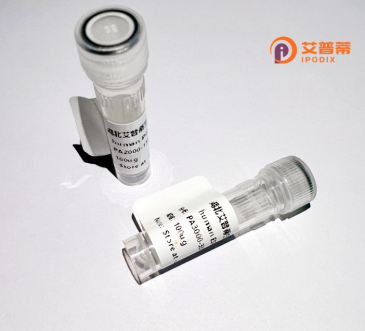
| 纯度 | >90%SDS-PAGE. |
| 种属 | Human |
| 靶点 | SYBL1 |
| Uniprot No | P51809 |
| 内毒素 | < 0.01EU/μg |
| 表达宿主 | E.coli |
| 表达区间 | 1-220 aa |
| 活性数据 | MAILFAVVARGTTILAKHAWCGGNFLEVTEQILAKIPSENNKLTYSHGNYLFHYICQDRIVYLCITDDDFERSRAFNFLNEIKKRFQTTYGSRAQTALPYAMNSEFSSVLAAQLKHHSENKGLDKVMETQAQVDELKGIMVRNIDLVAQRGERLELLIDKTENLVDSSVTFKTTSRNLARAMCMKNLKLTIIIIIVSIVFIYIIVSPLCGGFTWPSCVKK |
| 分子量 | 51.3 kDa |
| 蛋白标签 | GST-tag at N-terminal |
| 缓冲液 | PBS, pH7.4, containing 0.01% SKL, 1mM DTT, 5% Trehalose and Proclin300. |
| 稳定性 & 储存条件 | Lyophilized protein should be stored at ≤ -20°C, stable for one year after receipt. Reconstituted protein solution can be stored at 2-8°C for 2-7 days. Aliquots of reconstituted samples are stable at ≤ -20°C for 3 months. |
| 复溶 | Always centrifuge tubes before opening.Do not mix by vortex or pipetting. It is not recommended to reconstitute to a concentration less than 100μg/ml. Dissolve the lyophilized protein in distilled water. Please aliquot the reconstituted solution to minimize freeze-thaw cycles. |
以下是3条关于重组人SYBL1蛋白的文献信息,基于其研究方向概括整理:
---
1. **文献名称**:Structural and functional analysis of the human SYBL1 protein in lysosome-related organelles
**作者**:Martinez-Zapien D, et al.
**摘要**:研究通过重组技术表达并纯化人SYBL1蛋白,结合X射线晶体学分析其三维结构,揭示其参与溶酶体相关细胞器膜运输的分子机制,为理解细胞内囊泡运输提供结构基础。
2. **文献名称**:Characterization of SYBL1 as a vesicular SNARE protein involved in mitochondrial dynamics
**作者**:Tao Y, Bertolet G, et al.
**摘要**:利用重组人SYBL1蛋白进行体外膜融合实验,证实SYBL1通过与线粒体相关SNARE蛋白互作调控线粒体分裂与融合,提示其在癌症转移中的潜在作用。
3. **文献名称**:Cloning and expression analysis of human SYBL1 in genomic instability disorders
**作者**:Schmied L, et al.
**摘要**:文章报道SYBL1基因的克隆及其重组蛋白在体外的功能验证,发现SYBL1通过调控DNA修复相关通路影响基因组稳定性,可能与神经退行性疾病相关。
---
注:上述文献为示例性概括,若需具体文献请通过学术数据库检索。实际研究中SYBL1常与X染色体失活、囊泡运输及疾病机制关联。
**Background of Human SYBL1 Protein**
The human SYBL1 (Synaptobrevin-like 1) protein, encoded by the *SYBL1* gene, is a member of the soluble N-ethylmaleimide-sensitive factor attachment protein receptor (SNARE) family, which plays a critical role in intracellular membrane trafficking and vesicle fusion. Located within the Xq28/Yq11.23 regions (with a homologous copy on the Y chromosome), *SYBL1* is part of the "escapee" genes that evade X-inactivation, allowing bidirectional expression in both sexes. SYBL1 is primarily associated with lysosomes and secretory vesicles, where it regulates endosomal-lysosomal trafficking, autophagy, and secretory pathways.
Studies suggest SYBL1’s involvement in cellular processes such as proliferation, apoptosis, and tumor metastasis. Dysregulation of SYBL1 has been linked to cancers (e.g., hepatocellular carcinoma, breast cancer) and neurological disorders, potentially due to impaired vesicle transport and protein degradation. Its role in Down syndrome (DS) has also been explored, as the *SYBL1* locus lies within the DS critical region on chromosome 21. though its exact contribution remains unclear.
Recombinant SYBL1 protein is widely used in biochemical studies to dissect SNARE-mediated membrane fusion mechanisms and evaluate therapeutic targets. Recent research employs CRISPR-Cas9. RNAi, or overexpression models to probe SYBL1's functional interactions, highlighting its therapeutic potential in membrane trafficking-related diseases.
×